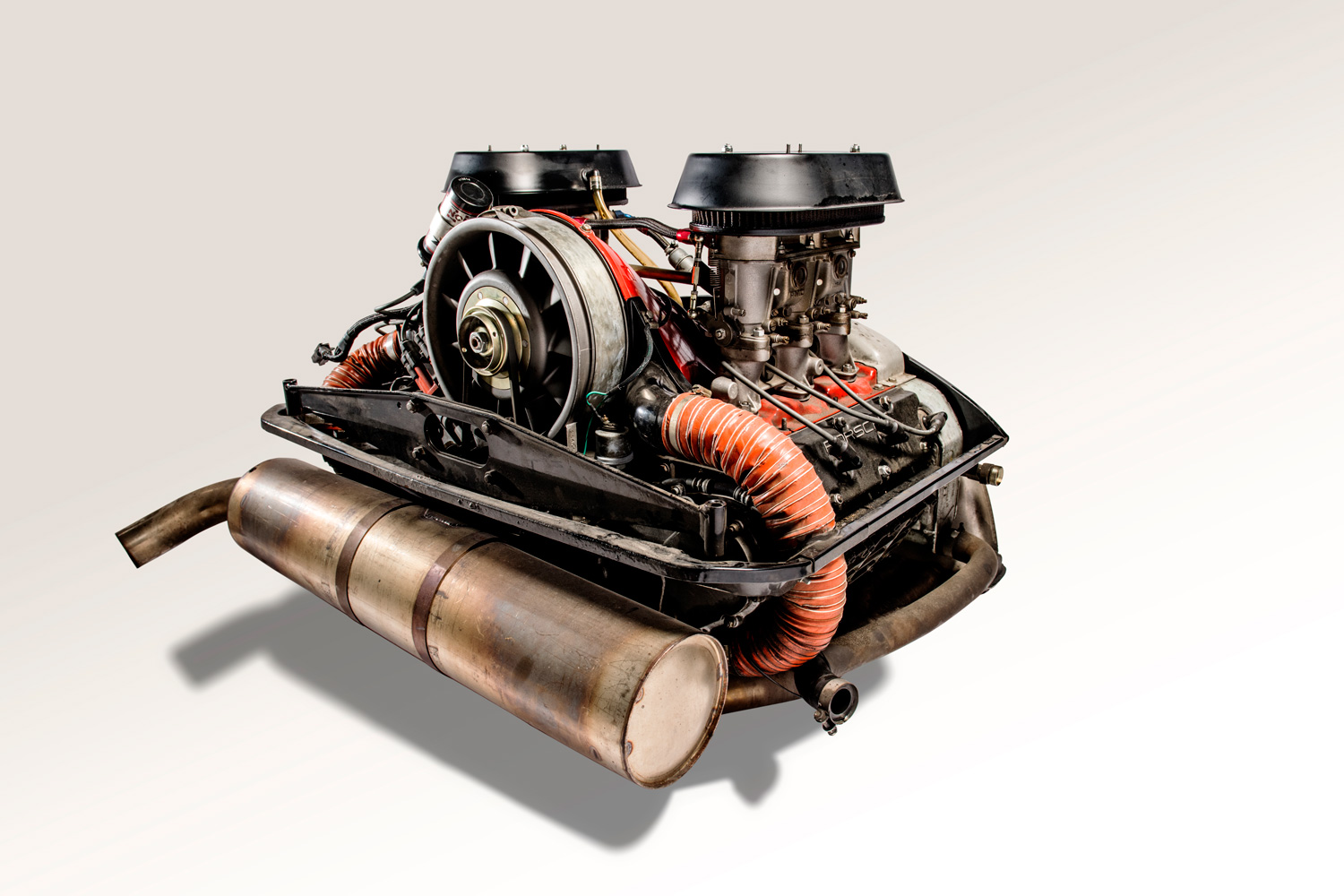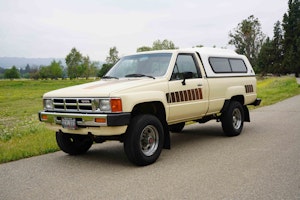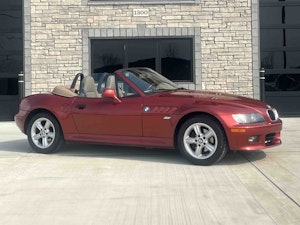Media | Articles
How Porsche’s brilliant air-cooled flat-six engine thrived for three decades
Car enthusiasts have dialed 911 more than a million times in the past half century, not for emergency assistance but to own the car that most succinctly defines Porsche’s essence. The 911’s heart and soul is a rear-mounted six with cooling provided by fins and a fan. This engine has its crankshaft in the middle, with three cylinders laid flat on each side. Vastly exceeding what you’d expect from a layout that descended from the VW Beetle, the 911 engine provides sparkling performance and a vivid personality. This magnetic combination has attracted parishioners to the Porsche faith since 1965.
The defining moment was the 1963 Frankfurt motor show, when Porsche debuted the successor to its four-cylinder 356 sports car and called it the 901. Peugeot, however, objected to the name on the grounds that it owned rights to all three-digit model designations with a zero in the middle. The 901 became the 911 before it reached European customers in ’64 and U.S. buyers the following year. Since nothing hindered Porsche from retaining the 901 code for internal use, the 911’s flat-six engine was so named.
Mezger on a mission

Hans Mezger, now 89, deserves most of the credit for the 901 engine. He joined Porsche in 1956 straight out of the University of Stuttgart’s engineering school and spent his entire 38-year career at Porsche’s headquarters in Zuffenhausen, Germany, working on engine design and development. Mezger is the brains behind practically every successful Porsche racing engine, including those that enabled McLaren to win five Formula 1 drivers’ and manufacturers’ championships in the mid-1980s.
In January 1963, when he began designing the 901, Mezger had expert assistance from founder Ferdinand Porsche’s son, Ferry, who established major goals based on the company’s past success. The first was a 130 DIN (148 SAE gross) horsepower target, matching the hottest engine ever sold in the 356. The second was Ferry’s “shoemaker, stick to your last” philosophy, which meant keeping the air-cooled, opposed-cylinder layout that had worked perfectly for the VW Beetle and Porsche 356. Although BMW, Citroën, Chevrolet, Ferrari, Lancia, Subaru, and others have manufactured flat engines over the years, none has matched Porsche’s ability to finesse this layout’s subtleties. Ferdinand Porsche’s grandson Ferdinand Piëch was on hand to guide the 911’s development; another grandson, Ferdinand Alexander “Butzi” Porsche, was responsible for interior and exterior design.
Marketplace
Buy and sell classics with confidence
The 356 Carrera’s 2.0-liter displacement was maintained in part because Germany’s post–World War II economy was still on the mend and gas prices were high. Mezger chose six cylinders as the happy medium between the 356’s four and Porsche’s Type 753 flat-eight engine under development for Formula 1. Spacing the bores 118 mm (4.65 inches) apart left ample room for larger future engines.
Cooling breezes

More than a dozen makers exploited air cooling in the 20th century, none so successfully as Porsche. Patriarch Ferdinand was an early adopter, beginning with Austrian manufacturer Austro-Daimler’s aircraft-engine design effort in 1912. Air-cooled engines with up to 12 cylinders and 360 horsepower followed for fighter aircraft, airships, helicopters, locomotives, and motorized gun carriages. After Daimler and Benz joined forces in 1926, Porsche helped that maker design an air-cooled two-cylinder motorcycle. When the Porsche Design Office opened in 1930, air-cooled engines for Zündapp and NSU were among the first projects.
Air cooling was an obvious choice for the German “peoples’ car” (Volkswagen) conceived in the early 1930s. Dispensing with the coolant, pump, hoses, and radiator trimmed cost and weight and helped make the engine compact enough to stash behind the rear wheels. In the 911, that same location left room for a front trunk and rear jump seats, adding utility to this sports car’s list of attributes.
Water conducts heat from a hot metal surface 175 times better than air. Designers committed to air cooling have three strategies at their disposal. The first is a fan to move the air much faster than liquid coolant circulates. The second is attaching fins to the cylinders and heads to increase the surface licked by airflow by a factor of 10 or more. Third is temperature differential. Liquid coolant circulates through an engine to the radiator at 160 to 230 degrees Fahrenheit; ambient air rarely tops 100 degrees. The greater the temperature differential between the engine and its cooling medium, the more heat is transferred away from hot areas. In a water-cooled engine, the temperature difference is typically 150 degrees versus up to three times that amount (450 degrees) with air cooling. Taking advantage of Mother Nature’s infinite heat sink is a shrewd choice for car, aircraft, motorcycle, and lawn-mower engines.
When the engineering dust settles, air-cooled engines are typically longer to provide space for fins between the cylinders. Liquid-cooled engines are quieter due to water jackets’ sound-absorbing properties and intermittent fan operation. Weight depends more on the materials used to construct the engine than the cooling medium. Cost is determined by the cleverness of a design and its production volume.
The 901’s 9.8-inch-diameter, 11-blade cooling fan resided in a fiberglass duct atop the engine and was spun by a V belt at 1.3 times crankshaft speed. Air drawn through decklid vents by the fan was blown through metal ductwork over the cylinders, heads, exhaust manifolds, and oil cooler, then out the bottom of the car. Flow through boxes surrounding the exhaust manifolds warmed the cockpit. The 901’s alternator was built into the hub of the cooling fan.
In a perfect world, cooling airflow would be proportional to the power produced by the engine. In Porsche’s crank-driven fan world, flow is proportional to engine rpm. To resolve that shortcoming, the 911’s fan is oversized to ensure ample flow during adverse circumstances.
Championship boxing

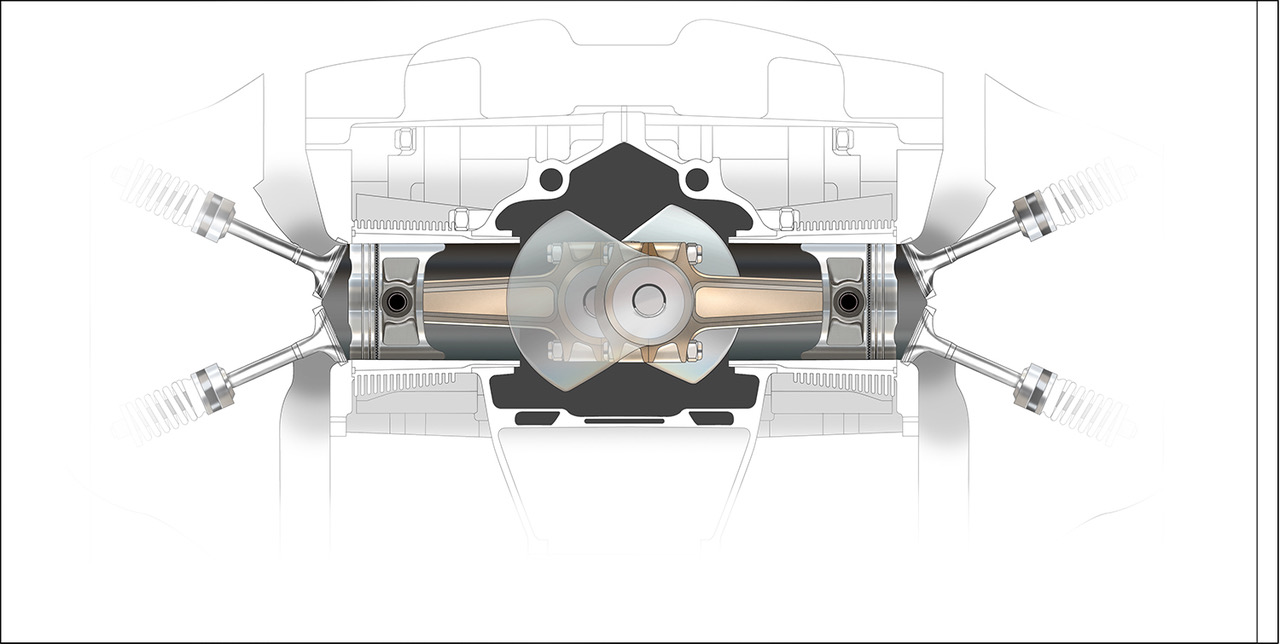
Ferdinand Porsche, who died in 1951 at age 75, passed his admiration of flat, opposed engines to his son. In 1897, Karl Benz patented what he called a “contra” engine, with two flat banks of cylinders astride a central crankshaft. The spark of genius was a crankshaft causing each opposed pair of pistons to mimic the motion of a boxer’s gloves: first toward the engine’s center line, then away toward the cylinder heads. Inevitably, such an engine was nicknamed “boxer.” The major attribute is virtually no vibration. The stop/start motion of one piston at the extremes of its stroke is balanced by the opposite piston’s moves. The only downside is the need for a separate crank throw for each rod and piston, slightly increasing the engine’s length, weight, and cost.
In addition to their inherent smoothness, boxer engines provide a lower center of gravity than V or upright inline engines, plus ample space for intake and exhaust plumbing. The boxer’s extra width poses no issue in Beetle and Porsche applications because of the wide-open space available behind the rear axle.
Given the flat engine’s natural balance, increasing the cylinder count for motorsports is relatively straightforward. Although a 16-cylinder version was only tested, Porsche’s flat-12 Type 912 engine powered 917K racers to the company’s overall victories at Le Mans in 1970 and ’71.
SOHC celebration

Another Ferry Porsche decree was no pushrod engines, after the 2.0-liter Type 745 designed in 1960 by Mezger’s predecessor, Klaus von Rücker, failed to produce the desired 148 horsepower. So Mezger positioned one cam atop each cylinder head (SOHC) to open two valves per cylinder via rocker arms. Spreading the valves 59 degrees apart optimized flow into and out of the domed combustion chambers.
Although the combustion chamber drawn by Mezger is commonly called a “hemispherical” or “hemi” design, that is a misnomer. “Hemi” implies half a sphere. Chambers that deep are undesirable because their large surface area wastes heat energy warming the head instead of driving the pistons. With a depth of 25 mm (0.98 inch) and a diameter of 82 mm (3.23 inches), the 901’s dome is only 30 percent (much less than half) of a sphere.
And what about today’s Hemis? Chrysler engineers studied the 901 combustion chambers while developing their current 5.7-to-7.0-liter V-8s. Although they’re all trademarked as Hemis, they ended up keeping little from Porsche’s 1963 design beyond widely splayed valves. Their combustion chambers are shallow bowls, far less than half a sphere in depth.
The 901’s hollow exhaust-valve stems were filled with sodium, which melts to expedite heat transfer from the burning-hot valve face to surrounding copper-alloy guides. (Copper is one of the most conductive metals known.) Lash—the requisite clearance between moving valvetrain parts—was set with adjusting screws located at the valve end of the forged-steel rocker arms.
Mezger kept the 745 engine’s 80-mm (3.15 inches) bore and 66-mm (2.60 inches) stroke dimensions because making the bore as big as possible provides more room for the larger valves needed for good high-rpm breathing. A six-throw, forged-steel crankshaft shared two features with the aforementioned 753 Formula 1 engine: narrow 22-mm (0.87 inch) rod and main journals to minimize length and maximize stiffness, and a special nitriding treatment. Plunging the crank and connecting rods into a molten cyanide salt bath infused their outer surfaces with nitrogen and carbon, yielding improved wear resistance and less chance of crack formation.
The 901’s cast-aluminum crankcase was split vertically about its longitudinal axis and held together with 12 through bolts. Six cylinders plugged into large crankcase sidewall holes. Eight main-bearing saddles—one on either side of each crank throw—provided excellent crankshaft support. A gear-driven auxiliary shaft below the crank powered two oil pumps and the two overhead camshafts.
After considering shafts, gears, and toothed-rubber belts to spin the cams, Mezger chose a proven double-row chain drive. Tension was maintained by an idler sprocket forced in contact with each chain by a hydraulically damped coil spring. An interesting noise-abatement measure was using 28 teeth on the crank-drive gear and 48 teeth on the auxiliary shaft’s driven gear to minimize the frequency of one crank gear tooth coming in contact with the same auxiliary-shaft gear tooth. Auxiliary-shaft and camshaft sprockets made up the difference to achieve the essential half-speed crank-to-cam drive ratio.
Cylinders supplied by Mahle were a “biral” design consisting of a thin iron bore surface surrounded by a liberally finned die-cast aluminum muff. This arrangement, also inherited from the 753 engine, provided ample surface area with cooling airflow over, under, and between the cylinders. Each cylinder was clamped in place by four long studs reaching through six separate aluminum heads to threads in the crankcase. One aluminum box per bank topped the heads to support one cam and six short rocker-arm shafts. Valves were closed by two springs wound in opposite directions with different rates to curtail float (hanging open due to their inertia) approaching the 6800-rpm redline.
Piëch urged Mezger to employ the best available materials: forged steel for the crank and rods; aluminum for the crankcase, cylinders, heads, cam carriers, and cooling fan to minimize weight and maximize heat rejection. (Aluminum’s thermal conductivity is three to four times greater than that of iron or steel.) Comprised of 16 major castings, Mezger’s 901 is the Lego set of engines. (In a typical inline-six, the cylinders, the crankcase, and the head require only two castings.) A fringe benefit with the modular approach is lower repair costs when a valve or piston fails. Replacing one cylinder, piston, or head assembly is typically cheaper than swapping out a block or head in a V-8 or inline-six.
Deluxe oil accommodations
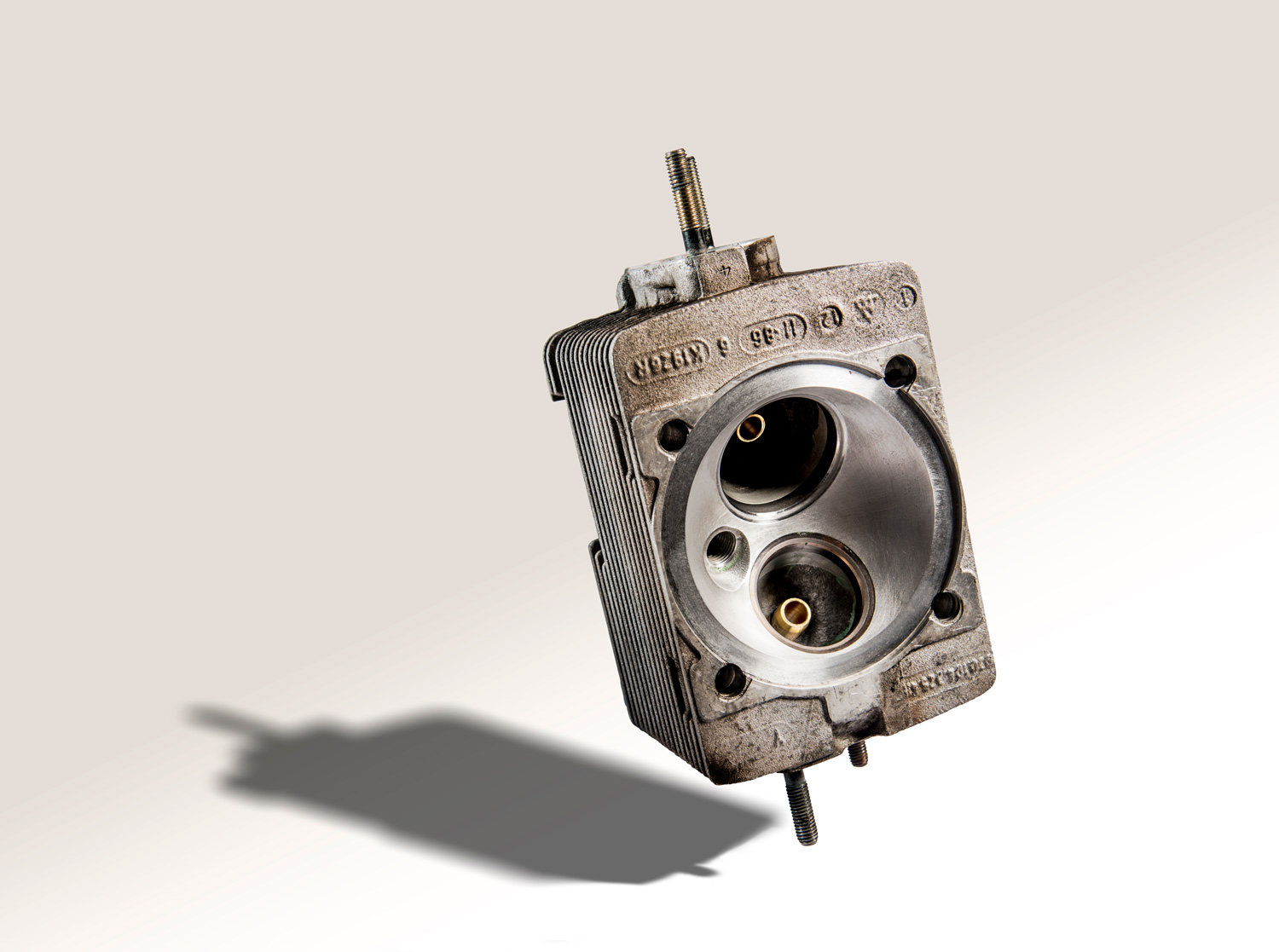
When a Type 821 experimental engine (another still-born flat-six designed for 901/911 use) suffered intermittent lubrication during hard cornering, Ferry Porsche approved the expense of a dry-sump system (oil stored in a remote reservoir) that provided several benefits: reduced windage losses (caused by the crank spinning in the froth over the oil); less overall engine height; a larger oil supply; and dependable lubrication during hard acceleration, cornering, and braking.
A pump scavenged lube from the bottom of the crankcase and delivered it through a filter to an eight-quart reservoir. A second pump sent oil through a cooler before feeding the main and connecting-rod bearings via internal crankcase passages and to the camshafts via external lines. The cams were hollow to deliver oil to the journals, lobes, rocker arms, and valve stems. Four large drain tubes returned oil from the heads to the crankcase. Taking advantage of the space available above the low-profile block and heads, six single-barrel Solex carburetors metered the fuel and air. A Bendix electric pump brought fuel from the 911’s front tank to float chambers attached to the intake manifolds. Two cam-driven recirculating pumps then transferred gas from the float chambers to the carburetors.
Mezger’s baby weighed 405 pounds at birth and delivered 148 horsepower from 122 cubic inches (1991 cc). The 901 engine’s specific output (horsepower per cubic inch of displacement) topped that of big- and small-block Chevy V-8s, the Mercedes-Benz SL’s SOHC six, and Jaguar’s E-type DOHC six. And there was more to come as the 901/911 grew and evolved during its long and fruitful life.
In 1965, Car and Driver magazine clocked the new 911’s run to 60 mph in 7.0 seconds and measured a top speed of 130 mph. C/D editors proclaimed Porsche’s prodigy “the stuff of legends” and “one of the world’s best GT cars.” In this case, the writers were on the mark, as the 901 engine enjoyed an extraordinarily long life and remained in service until 1998.
33 years of air-cooled evolution

1965: (after only a few thousand 911s had been delivered): When low-rpm valvetrain lubrication proved inadequate, internal camshaft oil delivery passages were superseded by a spray bar that showered journals, lobes, and rocker arms with oil.
1966: To remedy a 2500-3000 rpm flat spot in throttle response and the occasional engine fire when the remote fuel reservoirs leaked, Porsche offered an update kit containing new Weber 401DA-3C carburetors and new intake manifolds. A California firm PMO (Porsche Mail Order) currently offers a complete set of modern Weber carbs, manifold, linkage, and air filters for about $3000 to retain the period look.
1967: The factory’s success racing tuned 911s brought a 180-horsepower 911S street model with forged pistons, compression upped from 9.0 to 9.8:1, more aggressive valve timing, larger valves and ports, more efficient exhaust headers, and carburetor revisions. C/D cheered, “Oversteer is back and Porsche’s got it!” Top speed climbed to 140 mph, 0-60 fell to 6.5 seconds. Porsche’s own brochures advised ‘this is no car for a novice.’
Base 911s got the improved headers and milder cam profiles but no hike in power rating.
Rocker arms were switched from forged-steel to cast-iron to serve as fuses in the event a cam timing issue resulted in valve- to-piston collisions. Rocker arm lubrication was improved by adding more holes in the oil spray bar.
1968: New emissions controls included an air pump, a throttle-position valve, and ignition vacuum advance.

1969: To diminish the 911’s tail wagging and to take advantage of experience gained with the Carrera Six race engine, Porsche switched several castings from aluminum to magnesium. Mahle made these parts by squirting molten mag at 7000 psi into 1200-ton dies. The new crankcase was 22 pounds lighter. While the magnesium material cost more than aluminum, some of that expense was offset by a 30-percent reduction in machining requirements attributable to the more precise die-castings.
Magnesium, one of the most common materials in the earth’s crust, is two-thirds as dense and stiff as aluminum while providing 80 percent of its strength. China manufactures most of the world supply by heating dolomite ore and ferrosilicon in a sealed chamber, yielding a top layer of pure magnesium. Care must be exercised handling the easily ignited, hot burning magnesium chips produced during machining. Magnesium is the metal inside a photo flash bulb and is a favorite means of lighting campfires.
Unfortunately there were problems with the lighter crankcases when the 911’s displacement grew beyond 2.7 liters in 1978. The stress of more heat and higher crankcase loads caused failed threads, oil leakage, and corrosion issues.
A new 911T model was rated at 125 horsepower. Plug fouling and high-rpm misfiring issues were resolved by a new Bosch capacitive discharge ignition system. Fitting this ignition and modern platinum or iridium electrode sparkplugs to earlier models has become a common 911 service practice.
A new 911E (for einspritz or injection) was equipped with Bosch mechanical fuel injection developed by the motorsports department. Drivability and emissions were both improved and peak output climbed to 158 horsepower.
The 911S also received larger valves upping its rating to 190 horsepower.

1970: While other brands suffered major performance losses attributable to emissions controls and lower-octane fuel, Porsche avoided that plight by increasing displacement to 2195 cc with a larger 84-mm (3.31in) bore for all 911s. Larger valve diameters improved breathing while shallower combustion chambers addressed detonation concerns. To diminish fouling, heli-coil thread inserts were eliminated to improve spark plug-to-head heat transfer.
In the interests of durability, head gaskets now had a C-section ring sitting in a cylinder groove, connecting rods were stronger, and the auxiliary shaft had new bearing inserts at its forward end. The Weber carburetors fitted to 911Ts were replaced by Zenith 40 TIN units.
The original 901 engine designation was switched to 911 when Porsche’s parts system was updated.
1971: New oil squirters aimed at the bottom surfaces of the pistons dropped their peak crown temps by 120-degrees F.
1972: Stretching the stroke to 70 mm (2.77 in) raised displacement to 2341 cc (143 cubic inches). Rounding up, Porsche used 2.4-liters in badging. All 911s received a new fully-counterweighted forged-steel crankshaft. To comply with emissions standards, the 911T received fuel injection and a new 157-horsepower rating. The 911E got new valve timing and a 185-horsepower rating. The 991S engine dialed in with 210 horsepower.
1973: Peter Gregg and Hurley Haywood scored the 911’s first international endurance racing victory with a Carrera RSR at the 24 Hours of Daytona.
New Bosch K-Jetronic continuous-flow fuel injection and milder valve timing helped the 911T meet tightening emissions standards. While engine output was greater, a switch from gross to net horsepower ratings dropped the 911T rating to 134 horsepower. The 911E dropped to 157 horsepower and the S to 181 ponies.

1974: A larger 90-mm (3.54-in) bore raised 911 engine displacement to 2687 cc (164 cubic inches). The iron bore liners were supplanted by new Nikasil bore surfaces originally developed for 917 and Carrera RSR race engines; they consisted of a thin layer of wear resistant nickel-silicon-carbide applied to the aluminum cylinders by electroplating. The Nikasil process soon evolved to a less costly Alusil etching process to expose the silicon carbide combined with a thin iron coating plated onto the aluminum pistons. The magnesium crankcase castings received additional reinforcements.
K-Jetronic injection spread across the lineup which consisted of a base 911 with 143-horsepower, and 911S and a new Carrera, both rated 167-horsepower.
1975: To comply with California emission standards, 911s received exhaust gas recirculation and thermal reactors attached to their exhaust systems. All models were equipped with air-injection pumps to foster external combustion of pollutants. While base output held at 143 horsepower, the 911S and Carrera dropped to 157-horsepower.
1976: The remarkable Turbo Carrera was powered by a new 930 engine with more widely spaced cylinder and head retaining studs. Its companion was the 911S with 157 horsepower. To increase air flow at high rpm, a new five blade fan replaced the 11 blade design which was driven at 1.8 instead of 1.3 times crank speed. This arrangement also reduced engine noise.
1977: Air injection and thermal reactors swept across the entire U.S. 911 lineup without disturbing the 157 horsepower output.
Cam-chain housings, covers, and valve covers were switched from magnesium to die-cast aluminum.
To diminish the likelihood of stripped crankcase threads, a new Dilavar material was adopted for cylinder and head retaining studs. In contrast to the previous fasteners, this special steel alloy containing nickel and iron nearly matched the expansion rate of the aluminum and magnesium components, thereby reducing thermally induced stress. Because Porsche’s solution wasn’t foolproof, engine builders often replace the Dilavar studs with ARP or Supertec Performance steel hardware.
1978: Lessons learned with the 930 Turbo yielded a new Type 930 engine for the 911SC with 172 horsepower from 3.0 liters. The Turbo was bored and stroked, yielding 3.3-liters and 253 horsepower. Adding the world’s first production engine intercooler (to drop the temperature and increase the density of the incoming air charge) allowed increasing the compression ratio from 6.5 to 7.0:1.

1980: Due to tightening emissions standards, the king-hell Turbo went on a six-year hiatus. The addition of an exhaust oxygen sensor (to help control the fuel-air ratio) and a three-way catalytic converter kept the 911SC viable. A larger, slower turning fan improved engine cooling.
1981: Steel replaced plastic as the fuel line material. Better cold-start fuel-air mixture control diminished the likelihood of backfiring. The compression ratio climbed to 9.3:1 with no change in the 172 horsepower rating.
1984: The 911’s name changed to Carrera; a new 3.2-liter engine with integrated electronic control of fuel and ignition systems provided 200 horsepower.
1986: The renamed and fortified 911 Turbo returned to Porsche’s fold with 282 horsepower from 3.3 liters. The Carrera’s digital electronic controls were recalibrated to take advantage of premium fuel, yielding 214 horsepower.
1988: Ceramic liners were added to the exhaust ports to help usher heat to the turbocharger.
1989: The new 964 Series 911 embodied lessons learned from the 959 supercar with power supplied by a Type M64 3.6-liter flat six.
1991: Intake manifold materials were switched from cast-aluminum to fiberglass. A significantly larger intercooler and new turbocharger upped the Turbo’s Type M30 engine’s output to 320 horsepower.
1994: For the new 993 Series 911, the Turbo engine was upsized to 3.6-liters yielding 360 horsepower. Sharing that displacement, the new 911 Carrera now produced 270 horsepower thanks to its less restrictive hot-film air-flow sensor and a more efficient exhaust system. Hydraulic lash adjusters diminished maintenance requirements.

1996: Adding a second turbocharger and updated engine management electronics to the 911 Turbo raised output to a nice round 400 horsepower. The Carrera’s new Varioram intake system lifted mid-range torque by 18 percent and maximum output to 282 horsepower. Like a trombone’s slide, this system adjusted both runner length and plenum volume to achieve power-enhancing resonance—think motor music–within the intake system.
1998: This was the last hurrah for Porsche’s air-cooled engine, now offered only in naturally aspirated form.
1999: As competitors moved to double-overhead cams and four-valves per cylinder in pursuit of improved performance with lower emissions, Porsche responded with track-proven liquid cooling technology for a new Type 996 911. The water-cooled 24-valve 3.4-liter Type M96 engine rated at 296 horsepower was showcased within new bodywork.
Thirty-three years is a long life for any engine. Air-cooled 911s remain highly sought after because of their distinctive personalities and stirring performance. That rattlesnake whir you hear every time one starts as a lasting tribute to designer Hans Mezger and his accomplished collaborators.
The article first appeared in Hagerty Drivers Club magazine. Click here to subscribe to our magazine and join the club.
